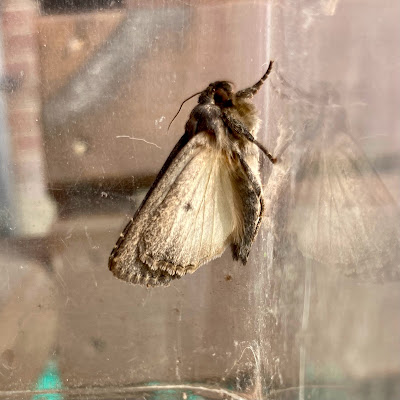 |
| Phasia obesa |
A re-appraisal of a photo from March 21st 2021 - also identified Nomada fucata. A record that at the time I had submitted to the UK BWARS Facebook page for verification. Then had promptly forgotten about it. The list now stood at 502.
Overnight, the 20W Actinic Skinner Trap proceeded to furnish me with 13 new moths, from amongst the 143 of 66 species. When the moth trap intruders (4 of 3 species) were collated, Wasp Spider was added, bringing the day's total to 17 new invertebrates for the garden. A day's haul worthy of the first few weeks of moth-trapping, whereby nearly every other moth was by virtue of novelty, new for the garden.
 |
| male Wasp Spider |
Of all the new records that day, it was the male Wasp Spider that really caught my imagination. I have only seen this species twice previously - once in Madeira and again a single specimen on Portsdown Hill - both females.
Spiders in general being one of the many weak points in my identification skill set - I ran the spider past the UK Spiders Facebook Group for verification. With the identification confirmed - the following weeks and months found me scouting for girls and their unmistakable webs throughout the wildflower lawn. To no avail.
Last Sunday, I cut back the wildflower lawn. The strimmer not being up to the task I selectively used the hedge-cutter. Although back-breaking this was less intrusive in its cutting affect and enabled me to keep my eye-in to avoid shredding anything of note. As always, I left patches of the lawn uncut, as refuges. I made a mental note to invest in a scythe for next autumn.
This afternoon, taking a stroll around the denuded lawn I noticed an orb about the size of a human eyeball hanging on to the top of a grass stem. Then a second, and a third. Not entirely sure what I was looking at - I picked one up. A seed head perhaps? However, knowing the local wildflowers, this did not make sense?
 |
| Wasp Spider egg-sacs |
I carefully pulled open the papery exterior, revealing a brown fibrous inner - with a core comprising a dense white structure. It finally dawned on me that this was a spider's egg-sac and given its size - I reckoned Wasp Spider was a good candidate. A Google search, confirmed the ID.
 |
| Wasp Spider egg-sac - opened |
The opened egg sac has gone into the spare fish tank, in the hope that I can successfully hatch the young - as it would be a shame to lose them to curiosity.



















































